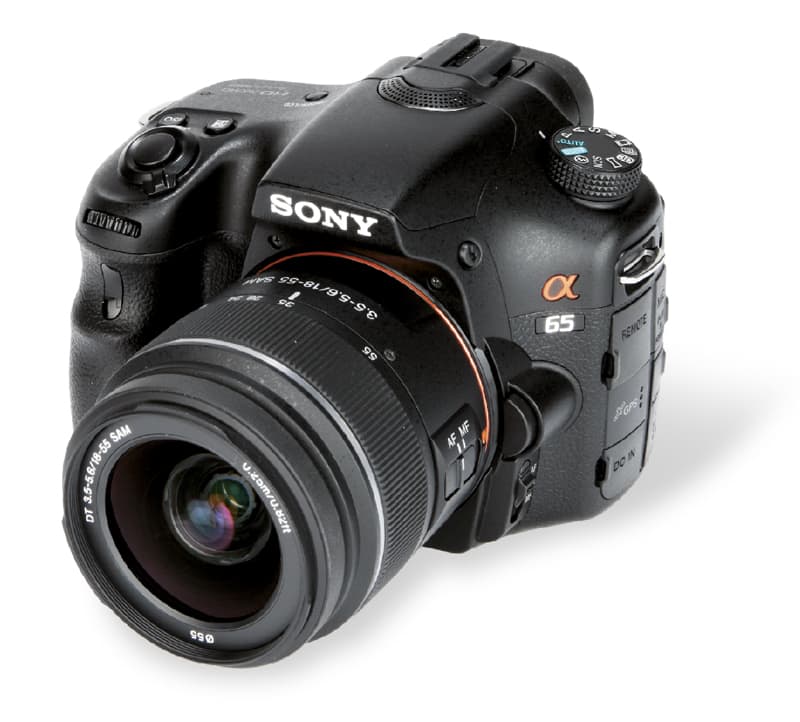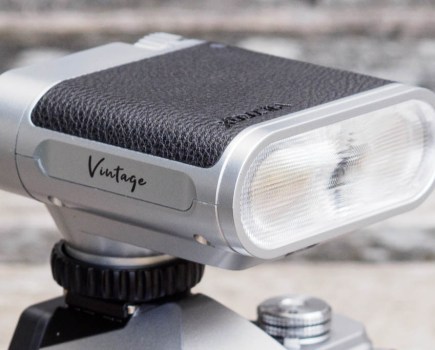Sony Alpha 65 at a glance:
- 24.3-million-pixel Exmor APS HD CMOS sensor
- 2.359-million-dot XGA OLED viewfinder
- 3in, 921,600-dot articulated LCD screen
- Up to 10 frames per second
- Street price £789 with 18-55mm kit lens
Sony Alpha 65 review – Introduction
The Sony Alpha 77 was named Enthusiast Camera of the Year and was voted Product of the Year by our readers in the 2012 AP Awards. The camera’s imaging sensor and electronic viewfinder (EVF) are its two standout features – and that same excellent sensor and EVF are found in the pared-down and significantly less expensive Sony Alpha 65 on test here.
The announcement of the Alpha 65 and Alpha 77 in August last year brought the current Sony Alpha single lens translucent (SLT) camera range to four models, as they join the Alpha 35 and Alpha 55 that were launched a year earlier.
Although the Alpha 65 and Alpha 77 share a number of key features, there are a few differences in the build, handling and core performance, such as the AF system. As the lower specified of the two, the Alpha 65 will always exist in the Alpha 77’s shadow.
However, the significantly lower price point should make the Alpha 65 a very popular model. It may in turn edge out the Alpha 55 as Sony’s most popular low-end enthusiast-level SLT, placing it against the likes of the Nikon D5100 and Canon EOS 600D.
Features

Sony’s Alpha 65 has the same class-leading 24.3-million-pixel, APS-C-size, CMOS sensor as that fitted in the enthusiast-level Alpha 77. The sensor has a 6000×4000-pixel output in the common Bayer-pixel arrangement.
At the maximum output and 300ppi resolution, digital files can be printed at A3+ size without any need for upscaling, while reducing the resolution to 240ppi is acceptable for even larger prints. In short, the high resolution makes large prints possible without loss in image quality.
Single lens translucent cameras have a translucent fixed mirror between the lens and the imaging sensor. The mirror reflects roughly 20% of the light entering the lens onto the autofocus sensor.
This constant exposure of the AF sensor to light provides the benefit of full-time autofocus, which is
a clear advantage for continuous shooting and video recording. However, reducing the imaging sensor’s exposure to light by 20% will always result in higher levels of noise. Just how noticeable this noise is depends on the camera’s settings and the available light in the scene.
Sony’s SteadyShot Inside sensor-based image stabilisation is included in the Alpha 65. This shifts the sensor to compensate for movement, giving an extra 2.5-4.5EV of handholdable shutter speeds, depending on the lens being used.
A shooting rate of up to 10 frames per second is possible when the continuous priority AE mode is selected on the shooting-mode dial. This frame rate is available for both raw and JPEG capture, in 11 and 17-frame bursts respectively. However, to retain exposure control, the maximum possible frame rate is 8fps, again for 11 and 17 shots respectively.
A real standout feature is the 2.359-million-dot XGA OLED electronic viewfinder (EVF). In our test of the Alpha 77 (see AP 15 October 2011), we commented that it is the best of its type to date.
The Alpha 65 is available as body only or as a kit with an 18-55mm f/3.5-5.6 lens, whereas the Alpha 77 can be bought with a 16-50mm f/2.8 optic.

The Alpha 65’s in-camera lens corrections make a big difference, certainly in edge highlights where chromatic aberration is an issue
The available kit lens for each camera is a clear indication of the intended market for each model. The fact that both use the same imaging sensor, though, means that users will not get the most out of the Alpha 65 using the less expensive 18-55mm kit lens.
An alternative option is to buy the Alpha 65 body only and the 16-50mm lens separately, but this decreases the margin in price between the two camera models from £350 to £170. This is a common issue for a camera at this level.
As another example, the Nikon D5100 uses the same sensor as the more expensive D7000, but is only available with a cheaper lens as part of a kit.
Build & Handling

Like all Sony Alpha SLT cameras, the Alpha 65 sits nicely in the hand, thanks largely to the contours of the rubberised grips. Its body is smaller and lighter than that of the Alpha 77, yet it is larger than the Alpha 55 and virtually the same size as similarly priced cameras, such as the Nikon D5100 and Canon EOS 600D.
While the Alpha 77 is made of a durable magnesium-alloy, the Alpha 65 is constructed from polycarbonate. Low-end enthusiast-level cameras do not usually feature a top LCD, and the omission of one from the Alpha 65 is the most noticeable difference when the Alpha 65 and 77 are placed side by side. Camera settings on the Alpha 65 must therefore be checked via the LCD screen or EVF.
There are fewer buttons on the body of the Alpha 65 than on the Alpha 77, which affects the handling of some controls. For example, with only one dial – which is placed on the front of the camera just below the shutter release – the Av button needs to be depressed to alter aperture rather than the shutter speed in manual-exposure mode.
I find the joystick navigation of the Alpha 77 fiddly, so I am pleased that the Alpha 65 does not have this control. Instead, the menus are navigated via the four-way pad.
Like the Alpha 55, the LCD screen of the Alpha 65 is articulated from the hinge at the bottom and offers a wide degree of viewing angles.
White Balance & Colour
A colour bit depth of 23.4 bits, as measured by DxO Labs (www.dxomark.com), is very good for a camera at this level. I mainly used the standard colour mode because in good light the colours are punchy and vivid. Sony Alpha cameras, including the Alpha 65, typically show a strong rendition of greens and blues, which is great for landscape use.
There are several picture effects for the creative use of colour, including pop color, posterization (color or black & white), partial color (with yellow, red, green or blue options), high-contrast mono and rich-tone mono. All the picture effects are available in JPEG format only because in-camera processing is applied.
White balance is accurate enough in virtually all situations, and taking a custom white balance reading is a quick process
Metering
Sony uses its trusted 1,200-zone metering system in its SLT cameras and the Alpha 65 is no exception. In the majority of situations, the evaluative system meters very accurately. For critical metering, I find spot somewhat limiting because it works in line with the AF points in the central part of the frame. For subjects at the edge of the frame, I find dialling in exposure compensation a quicker and better method than spot metering to ensure an accurate exposure.
Autofocus
The Alpha 65’s autofocus system consists of 15 points in three groups, all in the central area of the frame. Three of the points are the more sensitive cross type. This is the same system as that found in the Alpha 55 and it has more cross-type points than any other system used in a low-end enthusiast-level camera. The Alpha 77 has a more sophisticated system with 19 points, of which 11 are of the cross type.
In everyday use and in good-contrast light, the Alpha 65’s autofocus system is very fast – provided the subject is in the centre of the frame. For fast-moving subjects, activating object-tracking AF helps the camera latch onto the subject.
When used in very low-contrast light, the AF system is slower. Over a number of low-light images, the Alpha 65 has a lower hit ratio of successful focusing than the Alpha 77, although unlike the Alpha 77 the Alpha 65 is not meant for professional use.
It is important to select the correct AF mode in tricky lighting conditions. For example, spot-focus mode selects the central AF point. In local mode any one of the 15 points can be selected, while wide mode automatically selects one of the points.
In zonal mode, one of the three groups can be selected as the AF point. Local works well for a very specific focal point, while zonal is good for larger areas. Any subject outside the central area of the frame must be moved into it, and the frame then recomposed with manual focus selected, to avoid refocusing during capture.
Noise, Resolution & Sensitivity

These 100% enlargements show how the 16-50mm f/2.8 lens is slightly sharper than the 18-55mm f/3.5-5.6 kit lens
With the same imaging sensor and fixed mirror as the Alpha 77, it comes as no surprise that the Alpha 65 delivers superb image quality. At the base ISO setting, the Alpha 65 reaches the 30 marker on our resolution charts.
In fact, the resolution chart results of the Alpha 65 trump many other enthusiast-level cameras. Using the 18-55mm kit lens seems like a waste on a sensor that this good. When using a camera with a fixed mirror, the downside is that less light reaches the imaging sensor.
As we showed in our article Sensor comparisons (AP 30 April 2011), even at base ISO settings there is a degree of luminance noise in Alpha SLT cameras. At the higher ISO ratings of ISO 3200 and above, noise is significantly higher and obvious in real-world images. This is an area where SLT cameras fall short of the DSLR competition.
Despite noise levels being more prominent at higher ISO sensitivities than in its competitors, the Alpha 65 is still able to resolve a lot of detail, reaching the 24 marker at ISO 6400.

These images show 72ppi (100% on a computer screen) sections of images of a resolution chart, captured using a Sigma 105mm lens. We show the section of the resolution chart where the camera starts to fail to reproduce the lines separately. The higher the number visible in these images, the better the camera’s detail resolution at the specified sensitivity setting.
Dynamic range
With the same sensor, the Alpha 65 has a near identical dynamic range performance to its more expensive sibling, the Alpha 77. On the measured data (www.dxomark.com), the Alpha 65 scores a dynamic range of 12.6EV compared to the 12.8EV of the Alpha 77 at ISO 100.
At ISO 12,800, the dynamic range of the Alpha 65 is 6.9EV, which is almost half its base ISO. This means that the Alpha 65 offers a wide dynamic range at lower ISO ratings, but shows a steady decline as the ISO sensitivity increases, with images tonally flatter when a higher ISO rating is used.
The rating of the dynamic range places the Alpha 65 roughly 1EV below the Nikon D5100, but 1EV above the Canon EOS 60D. In short, the available dynamic range in a single exposure is in line with the competition.
The sensor of the Alpha 65 is more densely packed with pixels than its competitors, which means they are smaller and collect less light individually. It is impressive, then, that the camera matches the performance of other, less densely packed sensors.
LCD, Viewfinder & Video
One of the key features of the Alpha 65 is its XGA OLED electronic viewfinder. We raved about this technology in the Alpha 77 review, and in turn it picked up our Innovation of the Year award for 2011.
The benefits of an EVF are its ability to view menus, which is useful considering the lack of a top LCD; display information, including a digital level gauge; its exposure preview for elements such as white balance and shutter speed; and the fact that focus magnification can be employed at 5.9x and 11.8x for closer viewing.
The EVF uses a progressive refresh rather than an interlaced signal, which results in a quicker refresh rate than other EVFs. In fast panning is there a hint of ghosting, which is an issue that does not affect an optical viewfinder. This is the best EVF to date.
Sony’s recent Alpha LCD screens use TruBlack technology for strong contrast and deep blacks. The Alpha 65’s 921,600-dot LCD screen picks up smudges very quickly, which makes viewing more difficult in bright light, so the screen benefits from a regular clean.
Like the Alpha 55, the Alpha 65’s screen is articulated from a single hinge point on the bottom and offers fantastic flexibility for multi-angle viewing. The Alpha 77 uses a dual-axis articulation for even more versatile viewing.
To date, Sony Alpha SLT cameras have the edge over the competition when it comes to video recording, thanks to the fixed mirror set-up giving full-time phase-detection AF. Furthermore, 1080p AVCHD files can be recorded at 25p and 50p.
Our verdict
The Alpha 65 has the feel of the less expensive Alpha 55, but comes equipped with the excellent 24.3-million-pixel sensor found in the Alpha 77.
To get the most out of the sensor, opting for the 16-50mm f/2.8 lens over the 18-55mm f/3.5-5.6 kit optic is advisable. However, the size and weight of the 18-55mm lens better suits the Alpha 65’s build.
Compared to its competition, the Alpha 65 has the best image quality in good light without a doubt. The camera’s overall performance, namely its continuous shooting, has upped the bar for low-end enthusiast-level cameras to follow.







